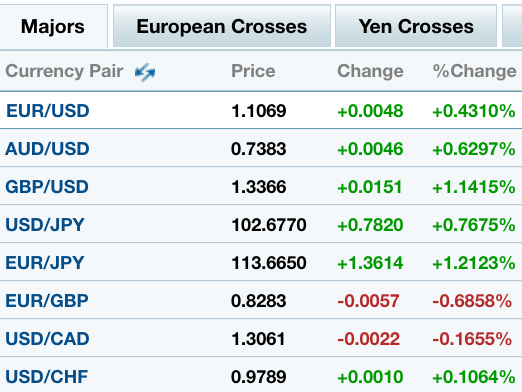This post is motivated by recent headlines suggesting that the Chinese yuan has depreciated in recent days. Here’s an example: China’s yuan weakens to 5-1/2 low as c.bank tolerates depreciation This headline is completely inaccurate – the Chinese yuan has been appreciating in recent days. So that’s one problem I’d like to fix. I’d like to see the media start reporting accurate data on exchange rates, so that we know what is actually happening to them. Not inaccurate information, which leads to bad public policy decisions. Another problem with the reporting of exchange rates is that it’s often done in a very confusing table, where sometimes a bigger number means the exchange rate has appreciated, and sometimes a bigger number means depreciation. Most of us now know that a bigger number means a weaker yen and a stronger euro, but who can keep straight the Canadian and Australian dollar, which are also not reported in a consistent fashion? I also get confused by exchange rates that are very close to one, like the Swiss franc: Click to enlarge. My proposal would solve both of these problems in one fell swoop. I propose that Bloomberg, or some similar company, create a table of currency indices.
Topics:
Scott Sumner considers the following as important: euro index, Featured, FX Theory, newslettersent, yen index
This could be interesting, too:
RIA Team writes The Importance of Emergency Funds in Retirement Planning
Nachrichten Ticker - www.finanzen.ch writes Gesetzesvorschlag in Arizona: Wird Bitcoin bald zur Staatsreserve?
Nachrichten Ticker - www.finanzen.ch writes So bewegen sich Bitcoin & Co. heute
Nachrichten Ticker - www.finanzen.ch writes Aktueller Marktbericht zu Bitcoin & Co.
This post is motivated by recent headlines suggesting that the Chinese yuan has depreciated in recent days. Here’s an example:
China’s yuan weakens to 5-1/2 low as c.bank tolerates depreciation
This headline is completely inaccurate – the Chinese yuan has been appreciating in recent days. So that’s one problem I’d like to fix. I’d like to see the media start reporting accurate data on exchange rates, so that we know what is actually happening to them. Not inaccurate information, which leads to bad public policy decisions.
Another problem with the reporting of exchange rates is that it’s often done in a very confusing table, where sometimes a bigger number means the exchange rate has appreciated, and sometimes a bigger number means depreciation. Most of us now know that a bigger number means a weaker yen and a stronger euro, but who can keep straight the Canadian and Australian dollar, which are also not reported in a consistent fashion? I also get confused by exchange rates that are very close to one, like the Swiss franc: |
My proposal would solve both of these problems in one fell swoop. I propose that Bloomberg, or some similar company, create a table of currency indices. Thus, instead of reporting exchange rates against the dollar, they would be reported against a weighted index of the 10 or 20 most important currencies. The numbers would all start at 100 on January 1st, 2017, and then proceed from there. For all currencies, a bigger number would mean currency appreciation, and vice versa.
Let’s take the recent example of the Chinese yuan. Why did Reuters wrongly report a depreciation appreciation in the yuan? Because the number of yuan required to buy one US dollar rose by about 1% in the days after Brexit, from 6.58 to 6.65. Notice how confusing that is – a bigger number means depreciation, not appreciation. But it gets worse. The dollar appreciated strongly against almost all currencies, up around 2% against the euro, Canadian dollar and Australian dollar. It fell slightly against the yen, but soared against the pound. So 2% is a ballpark figure for dollar appreciation. But that means the Chinese yuan actually appreciated by about 1% after Brexit, as it fell against the dollar by less than the dollar rose against other currencies.
Initially, I’d like to see a separate table reported, similar to the one above, alongside the old method. Each trade-weighted exchange rate would be reported as “US$ index” or “yuan index” or “euro index” or “yen index”, and in every case, a bigger number would mean currency appreciation. You’d never have the problem of the media reporting that a currency had depreciated, when it actually appreciated.
After a few years, people would start to migrate to the new and better way of reporting exchange rates, just as they gradually migrated from the Dow to the S&P 500 as a benchmark for the stock market. I’d like to see them continue to report the old table with exchange rate vis-a-vis the home currency as a benefit to tourists, but without the daily change. Changes in the exchange rate would only be reported on the index table.
PS: I suggest that a committee of interested parties, perhaps including the top business media outlets, sit down and agree on a set of countries to be used to construct the various exchange rate index numbers, so that there is consistency from one media outlet to another.
PPS: Why doesn’t the market solve this problem? Perhaps the combination of inertia and network externalities requires a “nudge” to move us to a better system.

